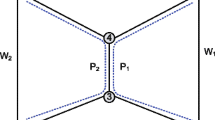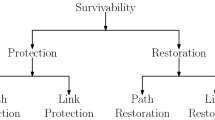Abstract.
In this paper, we consider the problem of routing connections in survivable wavelength-routed optical wavelength-division multiplexing (WDM) networks with wavelength conversion capabilities. A circuit-switched network architecture, using path-level protection to provide 100% protection guarantee to single link failures, is assumed. The blocking performance in such a network depends on the routing and wavelength assignment algorithm used and the amount of wavelength conversion available. Optical wavelength conversion, however is an expensive technology and may also cause signal degradation. Hence, it is important to effectively utilize the wavelength converters present in the network. With path protection, each connection is given a primary and a link-disjoint backup path. In this paper, we present four primary and backup route computation mechanisms that attempt to improve overall network performance compared to existing solutions. First, we present a routing algorithm, termed conversion free primary routing (CFPR) that tries to compute primary paths that do not require wavelength conversion. Next, we present a converter multiplexing technique that is used to share wavelength converters among multiple backup paths. We then propose a backup path relocation scheme that migrates existing backup paths, whenever needed, to accommodate more primary paths and also to obtain primary routes with fewer hops. Finally, we introduce modified CFPR (m-CFPR) that improves on CFPR by trying to find routes that will minimize relocations, while still maintaining the blocking performance. The proposed techniques are analyzed in detail using a discrete-event simulation model. The results show that significant reduction in blocking probability is possible with the proposed routing mechanisms. The converter multiplexing technique is seen to significantly reduce the number of connections blocked due to wavelength converter unavailability, and the number of wavelength converters required at each node, thus reducing system cost. The number of converters required at each node to achieve a given blocking probability is also seen to be four times lower, compared to existing architectures based on static shortest path routing. The proposed m-CFPR technique achieves the same blocking performance as that of CFPR, while requiring only one fourth the total number of relocations required with CFPR.
Similar content being viewed by others
References
K. Sivalingam S. Subramaniam (Eds) (2004) Emerging Optical Network Technologies Springer Publishers Boston, MA
D. Banerjee B. Mukherjee (1996) ArticleTitleA practical approach for routing and wavelength assignment in large wavelength-routed optical networks IEEE J. Sel. Areas Comm. 14 903–908 Occurrence Handle10.1109/49.510913
I. Chlamtac A. Ganz G. Karmi (1992) ArticleTitleLightpath communications: an approach to high bandwidth optical WANs IEEE Trans. Comm. 40 IssueID7 1171–1182 Occurrence Handle10.1109/26.153361
M. Sivakumar S. Subramaniam (2002) ArticleTitleOn the performance impact of wavelength assignment, wavelength conversion architecture and placement algorithms Opt. Netw. Mag. 3 IssueID2 44–53
Sivakumar, M., Shenai, R., Sivalingam, K.: Protection and restoration for optical WDM networks: A survey. In Sivalingam, K., Subramaniam, S. (eds.) Emerging Optical Network Technologies. pp. 297–331. Kluwer Academic Publishers (2004)
N.M. Bhide K.M. Sivalingam T. Fabry-Asztalos (2001) ArticleTitleRouting mechanisms employing adaptive weight functions for shortest path routing in multi-wavelength optical WDM networks J. Photonic Netw. Comm. 3 IssueID3 227–236 Occurrence Handle10.1023/A:1011495129926
Wen, B., Sivalingam, K.: Routing, wavelength and time-slot assignment in time division multiplexed wavelength-routed optical WDM networks. In: Proceedings IEEE INFOCOM, pp. 1442–1450. New York, NY, June, 2002
H. Zang J.P. Jue B. Mukherjee (2000) ArticleTitleA review of routing and wavelength assignment approaches for wavelength-routed optical WDM networks Opt. Netw. Mag. 1 IssueID1 47–60
I. Chlamtac A. Farago T. Zhang (1996) ArticleTitleLightpath (Wavelength) routing in large WDM networks IEEE J. Sel. Areas Comm. 14 IssueID5 909–913 Occurrence Handle10.1109/49.510914
K.-C. Lee V. Li (1993) ArticleTitleA wavelength-convertible optical network IEEE/OSA J. Lightwave Technol. 11 IssueID5 962–970 Occurrence Handle977629 Occurrence Handle10.1109/50.233260
S. Subramaniam M. Azizoglu A.K. Somani (1999) ArticleTitleOn optimal converter placement in wavelength-routed networks IEEE/ACM Trans. Netw. 7 IssueID5 754–766 Occurrence Handle10.1109/90.803388
G. Xiao Y. Leung (1999) ArticleTitleAlgorithms for allocating wavelength converters in all-optical networks IEEE/ACM Trans. Netw. 7 IssueID4 545–557 Occurrence Handle10.1109/90.793026
Subramaniam, S., Azizoglu, M., Somani, A.: Connectivity and sparse wavelength conversion in wavelength-routing networks. In: Proceedings IEEE INFOCOM, pp. 148–155 (1996)
S. Subramaniam M. Azizoglu A.K. Somani (1997) ArticleTitleConnectivity and sparse wavelength conversion in wavelength-routing networks IEEE/ACM Trans. Netw. 4 IssueID4 544–557 Occurrence Handle10.1109/90.532864
Krishnamurthy, H., Sivalingam, K.M., Mishra, M.: Restoration mechanisms based on tunable lasers for handling channel and link failures in optical WDM networks. In: Proceedings SPIE OPTICOMM, SPIE vol. 4874, pp. 39–50. Boston, MA, July 2002
O. Gerstel R. Ramaswami (2000) ArticleTitleOptical layer survivability-an implementation perspective IEEE J. Sel. Areas in Comm. 18 IssueID10 1885–1923 Occurrence Handle10.1109/49.887910
Ramamurthy, S., Mukherjee, B.: Survivable WDM mesh networks Part 1 - Protection. In: Proceedings IEEE INFOCOM, vol. 2, 744–751. New York, NY, March, 1999
C. Ou J. Zhang H. Zang L. Sahasrabuddhe et al. (2004) ArticleTitleNew and improved approaches for shared-path protection in WDM mesh networks IEEE/OSA J. Lightwave Technol. 22 IssueID5 1223–1232 Occurrence Handle10.1109/JLT.2004.825346
Qiao, C., Xiong, Y., Xu, D.: Novel models for efficient shared-path protection. In: Proceedings IEEE Optical Fiber Communications Conference (OFC), pp. 546 – 547. March, 2002
D. Zhou S. Subramaniam (2000) ArticleTitleSurvivability in optical networks IEEE Netw. Mag. 14 IssueID6 16–23 Occurrence Handle10.1109/65.885666
S. Sengupta R. Ramamurthy (2001) ArticleTitleFrom network design to dynamic provisioning and restoration in optical XC mesh networks: an architecture and algorithm overview IEEE Netw. 15 IssueID4 46–54 Occurrence Handle10.1109/65.941836
Choi, H., Subramaniam, S., Choi, H.-A.: On double-link failure recovery in WDM optical networks. In: Proc. IEEE INFOCOM, pp. 808–816. New York, NY, June, 2002
Clouqueur, M., Grover, W.: Mesh-restorable networks with enhanced dual-failure restorability properties. In: Proc. SPIE OPTICOMM, pp. 1–12. Boston, MA, July, 2002
He, W., Sridharan, M., Somani, A.K.: Capacity optimization for surviving double-link failures in mesh-restorable optical networks. In: Proc. SPIE OPTICOMM, pp. 13–24. Boston, MA, July, 2002
Doucette, J., Grover, W.D.: Capacity design studies of span-restorable mesh networks with shared-risk link group (SRLG) Effects. In: Proc. SPIE OPTICOMM, pp. 25–38. Boston, MA, July, 2002
Sivakumar, M., Maciocco, C., Mishra, M., Sivalingam, K.M.: A hybrid protection-restoration mechanism for enhancing dual-failure restorability in optical mesh-restorable networks. In: Proc. SPIE OptiComm, pp. 37–48. Dallas, TX, October, 2003
K.-C. Lee V. Li (1996) ArticleTitleA wavelength rerouting algorithm in wide-area all-optical networks IEEE/OSA J. Lightwave Technol. 14 IssueID6 1218–1229 Occurrence Handle10.1109/50.511623
G. Mohan C.S.R. Murthy (1999) ArticleTitleA Time optimal wavelength rerouting algorithm for dynamic trafic in WDM networks IEEE/OSA J. Lightwave Technol. 17 IssueID3 406–417 Occurrence Handle10.1109/50.749380
D. Banerjee B. Mukherjee (2000) ArticleTitleWavelength routed optical networks: linear formulation, resource budget tradeoffs and a reconfiguration study IEEE/ACM Trans. Netw. 8 IssueID5 598–607 Occurrence Handle10.1109/90.879346
V. Anand C. Qiao (2001) ArticleTitleStatic versus dynamic establishment of protection paths in WDM networks, part I J. High Speed Netw. 10 IssueID4 317–327
Sridharan, M., Somani, A.: Revenue maximization in survivable WDM networks. In: Proc. SPIE OPTICOMM, pp. 291–302. Dallas, TX, August, 2000
H. Zang B. Mukherjee (2001) ArticleTitleConnection management for survivable wavelength-routed WDM mesh networks Opt. Netw. Mag. 2 IssueID4 17–28
N.-F. Huang G.-H. Liaw C.-P. Wang (2000) ArticleTitleA novel all-optical transport network with time-shared wavelength channels IEEE J. Sel. Areas Comm. 18 IssueID10 1863–1875 Occurrence Handle10.1109/49.887908
Author information
Authors and Affiliations
Corresponding author
Rights and permissions
About this article
Cite this article
Gowda, S., Sivakumar, M. & Sivalingam, K.M. Protection Mechanisms for Optical WDM Networks Based on Wavelength Converter Multiplexing and Backup Path Relocation Techniques. Photon Netw Commun 12, 65–78 (2006). https://doi.org/10.1007/s11107-006-0015-4
Received:
Revised:
Accepted:
Issue Date:
DOI: https://doi.org/10.1007/s11107-006-0015-4




